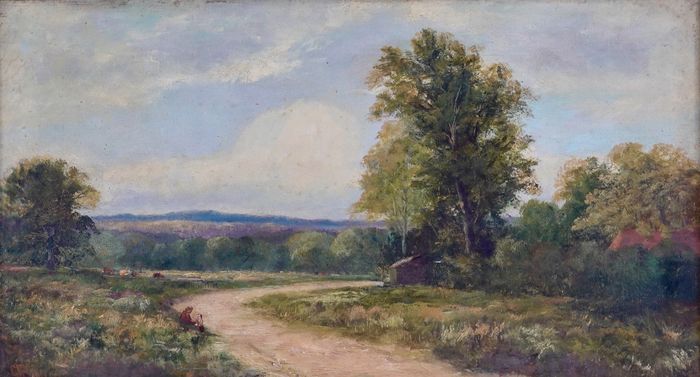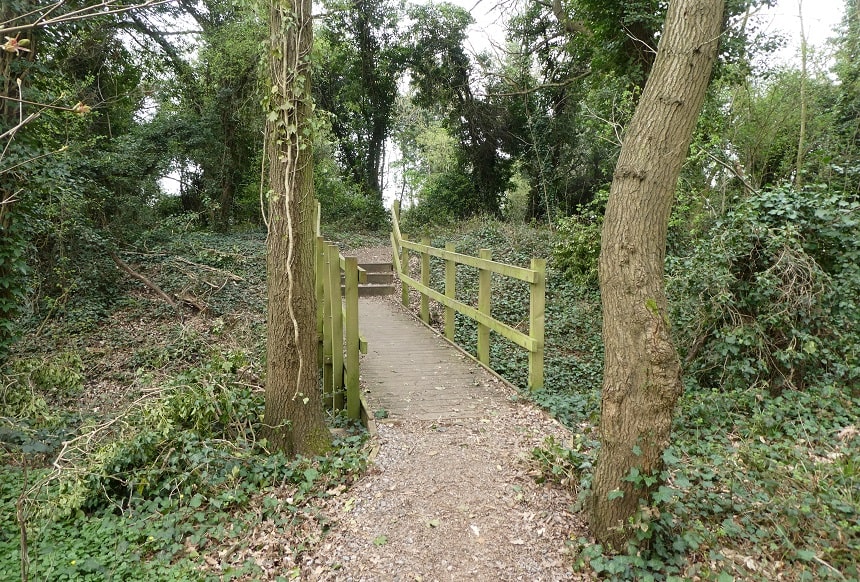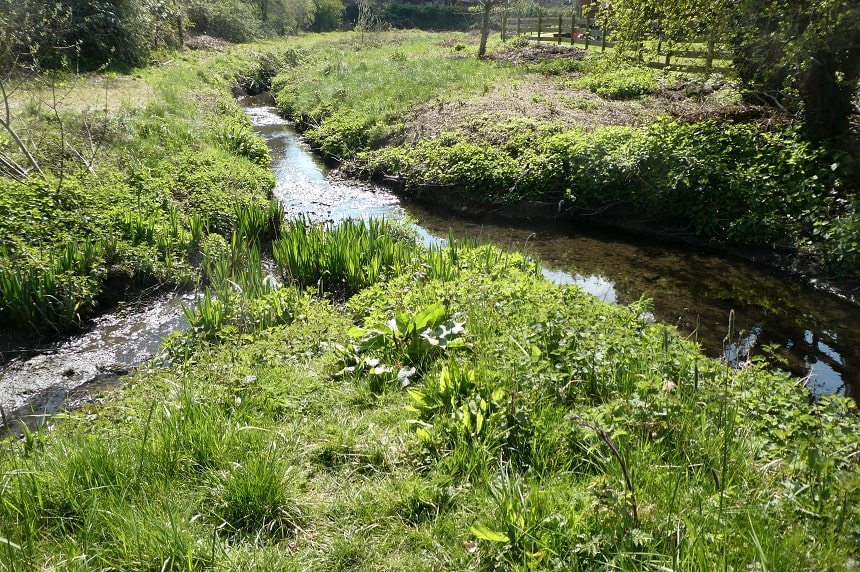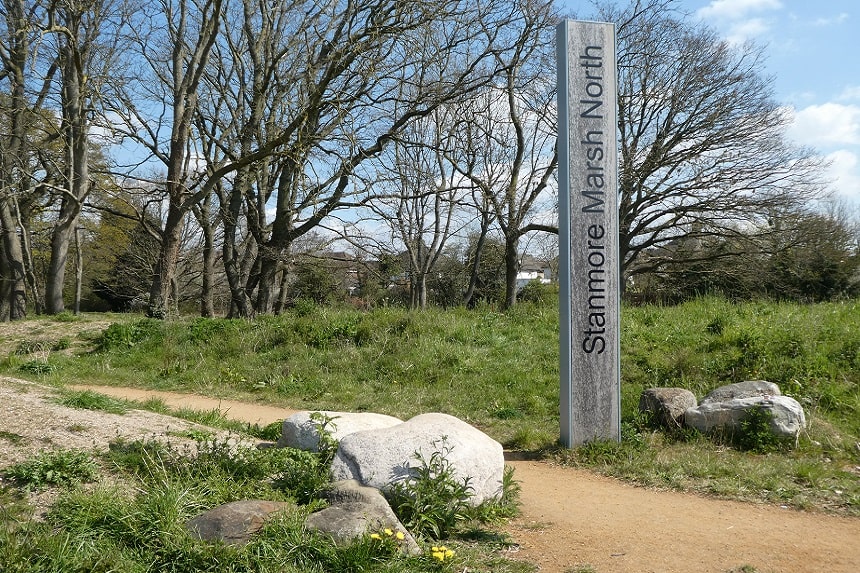The historic Stanmore Marsh sits along Great Stanmore’s eastern border, sandwiched between its neighbour Little Stanmore, on the crossroads of Honeypot Lane and Marsh Lane. The marsh is intersected by Whitchurch Lane creating Stanmore Marsh North and Stanmore Marsh South.
History
Originally the area was farmland with Marsh farm being in operation at least since 1520, later with Wards Farm to the north and Old church farm to the south, but the marsh sat to the east of the common fields so a decree of 1582 allowed certain tenants of neighbouring Little Stanmore the right to graze their livestock on the marsh too.
The soft boggy marsh terrain is probably how Honeypot Lane got its name. It was once said that in winter the ground was so wet and pliable that the way the mud would stick to the bottom of your shoes, it was like walking through honey, at times making it almost impossible to traverse. Although now a dual carriageway it was not that long ago that this was actually a country lane, and before that just a trackway, it could most probably trace its existence back to at least Roman times and possibly way back to the stone age. In all that time its layout changed very little except for the addition of a layer of tarmacadam. Up until Suburbia reached the area in the 1930’s it was quite a rural setting, with just a few cottages and public houses dotted along its route.
The last four cottages, known as Marsh Cottages which sat on the southern edge of the marsh were used as a location for the 1928 British silent spy classic Huntingtower starring Sir Harry Lauder, made out of a studio in Cricklewood, by the film director George Pearson.
The cottages were even granted grade II listing by harrow council but they became so neglected, permission was given to demolish them and the new development of Bramble Close was built. The nearest Public House the Green Man would have been a welcome sight to weary travellers heading down this one cart track, it had sold beer on this spot since at least 1851. The pub was rebuilt in the 1930’s when civilisation came to the area, and the little country lane became the present dual carriageway. The Green Man managed to survive another 70 years before the developers came knocking and it became Amber House in 2004.

To the north of the marsh sits the Stanmore Gas Works, this facility was built by a Mr. Penny on behalf of J.W. Chapman, and was opened in 1858 as the Great Stanmore Gas Co. Ltd. Chapman operated a similar company in Harrow supplying gas to the area. Eventually it was decided to amalgamate the two businesses in 1894 as, the Harrow and Stanmore Gas Company. The company operated a workers co-partnership scheme from 1912, but with the nearest station, Canons Park not opening until 1932 it proved difficult to get the coal to the plant which had to be delivered by horse drawn cart, an unproductive solution when so much of it was needed. It eventually closed as a production facility, but remained as a holder station and booster plant, and more modern holders were built, these could be used when extra capacity was needed in the gas network. By the early 1990’s most local gas networks were able to function at full capacity without the use of gas holders, so from 2000 most of the UK’s gasometers became obsolete and unused. Today at Stanmore, three gasometers are in situ and the small cottage at the entrance has been designated a listed building by Harrow council.
From Stanmore to the Thames
The soil around Stanmore is made up of heavy clay with bands of gravel and silt deposits. This mixture is quite dense and water would find it easier to run off its surface then to be absorbed. The stream running through the marsh started life as rain on the rolling hills in northern Stanmore. The water would trickle down and find its way into Summerhouse Lake in Bentley Priory. Then as the Stanburn would flow south-eastward, past Boot pond through a culvert under the Uxbridge Road and into Temple pond in Stanmore Park. Under Gordon Avenue through Montrose Walk down Old Church Lane, Wolverton Road. Across Abercorn Rd, through what was Carraras Sports ground and under Marsh Lane. Once here on the Marsh, It meets up with a water course which originates at Spring Ponds and the hills of Stanmore Country Park, flowing down Denis Lane to Marsh Lane and into the Marsh, the marsh itself being of softer soil became a natural sponge, a flood plain over time absorbing a lot of the water flowing into it. From here the water continues its journey as the Edgware Brook through Burnt Oak to Colindale, merging with Deans Brook becoming the Silk Stream, here it will flow through Hendon to The Welsh Harp, the River Brent, which is finally a tributary of the River Thames.
One of the main problems on the Marsh was that the water was being diverted underground in concrete tunnels, or overground with heavy wooden banks, in time the surrounding wetlands dry up and lose their ability to act as sponges retaining surpass water, nature’s way of storing water and helping to prevent flooding in London.

The Stanmore Marsh Restoration scheme
In January 2015 London Mayor Boris Johnson announced plans to improve local green spaces across London, with the ’Mayor’s Big Green Fund’ and a £900,000 kitty. Londoners voted for an array of projects and almost 1000 people voted for our marsh. The result was that Stanmore Marsh had been awarded a £175,000 share of the funding to revitalise the area.
There are hundreds of miles of streams running across and underneath London, and an ambitious plan has been rolled out to rewild them. As the nation’s capital grew streams were diverted using concrete tunnels and banks. Unfortunaly this process whilst keeping running water away from housing and foundations it stops the earth from taking out impurities in the water effectively stopping wildlife from inhabiting it.
A plan was put into action to rewild and transform the marsh. The process of rewilding streams takes them back to their natural state. By freeing the water from its concrete surround and allowing plants and reeds to be planted in its bed and banks, the vegetation allowing the water to become self-cleaning and allowing biodiversity to flourish. Here at the marsh many years ago the Edgware Brook was routed through a concrete tunnel, now after rewilding it, it travels through a more natural environment allowing wildlife to flourish here once again. Volunteers from Thames 21, an environmental charity, The London Authority, Thames Water and Harrow council, have worked together, and provided extra funding to help bring this project to fruition.
The result is that more than 4 hectares of green space has been opened up for public use, over 3,000m3 of flood storage have been created, equal in capacity to almost one and a half Olympic size swimming pools of water, and over 400 meters of paths have been laid crossing the site, so even when it’s at its capacity you won’t get wet feet exploring the area. So, as well as the woodland walks and nature trails the marsh now has natural ponds, seating areas, interesting oak monoliths with rubbing plates mounted on top, open streams and a secure children’s play area.
Mayor of Harrow, Cllr Margaret Davine, officially opened the Marsh with a ribbon cutting ceremony on Wednesday June 28 2017. The marsh is now a place where wildlife thrives Since the regeneration project many new verities of plants wildflower seeds have been sown can be seen growing including scarlet poppies and wild daisies. The old concrete and wooden bank lines have been taken out and replaced with a Flex MSE, a natural vegetated retaining wall system that will provide a better environment for a more diverse wildlife, habitat, ecology, flora and fauna to prosper, as well as permitting water to seep into the banks and surrounding land allowing these historic marsh lands to regain its sponge like qualities in soaking up excessive flood water.

The Marsh has been adopted in the Harrow UDP as a Local Wildlife Site of Borough Importance for Nature Conservation. Trees and shrubs growing on the marsh include pedunculate oak, sessile oak, willow, hawthorn, English elm and elder. More than 120 species of plant have been recorded here including the beautiful golden marsh marigolds which fringed the pool on the North Marsh, and the vivid blue of the alkanet flowers, wild flowers and native bluebells are a common site.
The wooded areas are frequented by a host of garden and woodland birds including the woodpigeon, blue tit, great tit, long-tailed tit, robin, magpie, green woodpecker, blackbird, goldfinch, wren, carrion crow, house sparrow, song thrush and starling. A number of nationally rare invertebrates have been noted in the wetland area as well as the more common toad. Nine species butterflies have been spotted including speckled wood, holly blue, brimstone, Small tortoiseshell, Peacock, Comma, Red Admiral, Large White and the Green-veined white.
Visiting Stanmore marsh is easy, the 79, 186 and 340 busses all run past the Marsh, and the site is an easy walk from the Canon’s Park Jubilee line station. For sat-nav directions use, Marsh Lane, Stanmore, HA7 1AH
Volunteers continue to keep the Marsh looking great all year round. If you would like to learn more, visit their Facebook page at The Friends Of Stanmore Marsh. Do check them out for information, regular updates and news on the Marsh.
